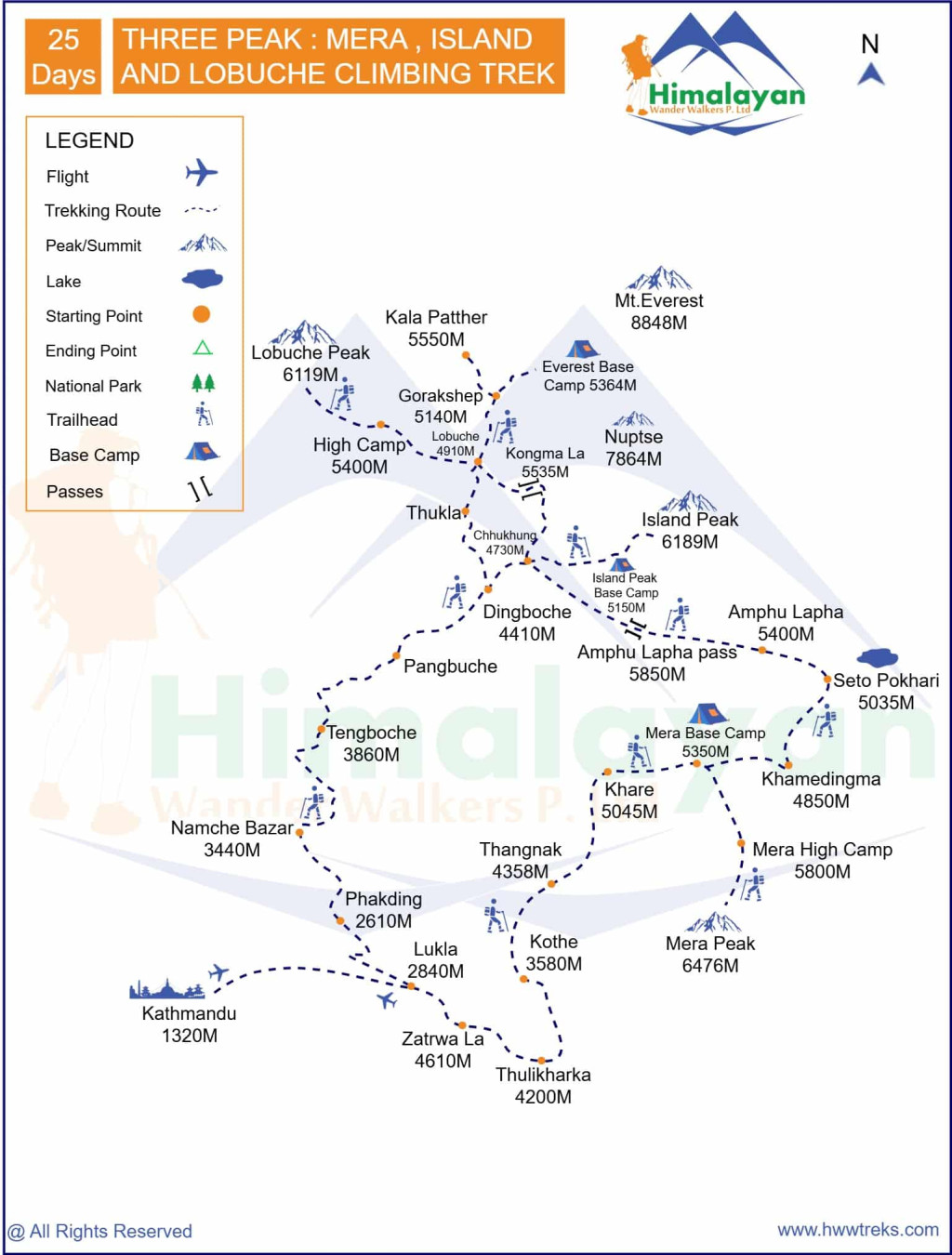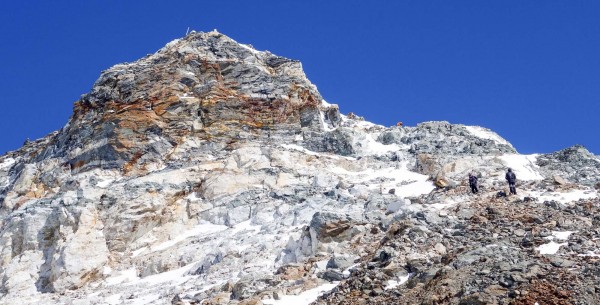Important Information
Region
Peak climbing and Expedition
Duration
25 Days
Max Altitude 6461m
Best Season March to May, September to November
Activity Per Day
6-7
Grade
Level Level 2
Group Size
2 - 12 people
Transportation Flight
The Three Peaks Climbing expedition offers an exhilarating adventure in the heart of the Himalayas, combining the thrill of mountaineering with the breathtaking beauty of the region. This specially organized expedition by Himalayan Wander Walkers lets you summit three iconic peaks, Mera Peak (6,461 meters), Island Peak (6,189 meters), and Lobuche East Peak (6,119 meters), in one single journey. Not only will you conquer these peaks, but you’ll also embark on an unforgettable trek to Everest Base Camp and Kalapathar, providing a complete Everest experience that will leave you with memories to last a lifetime.
Mera Peak (6,461 meters): The Highest Trekking Peak in Nepal
Mera Peak is the highest trekking peak in Nepal, at 6,461 meters. Located to the south of Everest, it offers unparalleled panoramic views of the Himalayan giants, including Makalu, Lhotse, and the mighty Everest. The trek to Mera Peak starts in the lush valleys of Hinku and Hongu Drangkas in Makalu Barun National Park and takes you through pristine alpine landscapes.
Though Mera Peak doesn't demand advanced mountaineering skills, it requires climbers to have some prior trekking and basic climbing experience. The ascent is less technically challenging compared to Island Peak, but the altitude and rugged terrain will still push you to your limits. The summit offers a truly exhilarating experience, providing sweeping views of the Himalayas.
The history of Mera Peak is as fascinating as its ascent. While it was first climbed in 1953 by J.O.M Roberts and Sen Tenzing, the proper ascent was made in 1975 by a French team. The route has since become a popular and accessible goal for climbers seeking an authentic Himalayan adventure.
Island Peak (6,189 meters): A Steep Challenge with a View
Island Peak, also known as Imja Tse, is a popular peak located in the Khumbu region, standing at 6,189 meters. This stunning peak, shaped like an island in a sea of ice, is surrounded by the glaciers of Lhotse and Lhotse Shar. The unique appearance of Island Peak makes it one of the most iconic peaks in Nepal.
Named by Eric Shipton’s expedition in 1952, Island Peak was first ascended in 1953 as part of a preparation for the Everest Expedition by climbers like Tenzing Norgay and Charles Evan. The climb to Island Peak is technically more demanding, involving ice axes, crampons, and ropes to navigate steep snow slopes and icy sections. Climbers must have basic mountaineering skills to successfully summit this peak.
Beyond the physical challenge, the view from the summit of Island Peak is awe-inspiring, with sweeping views of Everest, Lhotse, Nuptse, and the surrounding Khumbu region. The satisfaction of standing on top of this Himalayan giant is unmatched.
Lobuje/Lobuche Peak (6,119 meters): A Challenge for Every Mountaineer
Lobuche Peak or Lobuje, located in the Khumbu region, is challenging yet rewarding for aspiring mountaineers. At 6,119 meters, Lobuche East is slightly lower than Island Peak but offers its own set of technical climbing challenges. The climb requires climbers to use ropes, crampons, and ice axes as they navigate steep slopes, crevasses, and snow-covered terrain.
What makes Lobuche East unique is the stunning backdrop of some of the world’s tallest mountains, including Everest, Lhotse, Nuptse, and Pumori. The peak offers climbers a perfect blend of technical difficulty and mesmerizing views. Most climbers approach Lobuche East as part of the Everest Base Camp trek, making it a perfect combination of high-altitude trekking and mountaineering.
For beginners, Lobuche East Peak serves as a solid first step in Himalayan climbing. Though challenging, it is less technical than other major peaks in the region, making it ideal for those looking to test their skills without the intensity of a full-scale Everest climb.
If you are looking for a different itinerary than the itinerary here, please Customize Your Trip.
*If you are booking for spring season (March, April and May). The given price will increase by USD 525 due to Peak Permit fee higher in season.
Include
Your Standard meals(Breakfast, Lunch,and Dinner) during trekking
All Trekking & Climbing permit
Necessary Trekking, Climbing equipment
All aacommodations in lodges/tea houses during the treks
An experienced, helpful and friendly trekking and climbing guide, porters
Trek arrangements with tents, cook, and porter/s (NMA Registered Climbing Guide for trekking and climbing) .
Arrangement of Emergency Helicopter service which will be paid by your Travel insurance company.
Medical supplies (first aid kit will be available).
All government taxes & service charge
Exclude
Nepal entry visa and International flight ticket
Travel insurance
Lunch and dinner in kathmandu
Climbing boots
All Bar Bills and personal expenses( phone call, laundry services, battery recharges, bottles of water, hot water,shower)
Tips for the guide and porter
Route Map

Important Information
Why Choose the Three Peaks Climbing Expedition?
The Three Peaks Climbing Expedition offers more than just a mountaineering challenge, it’s a complete Everest adventure. You’ll get to experience the majestic peaks of Mera, Island, and Lobuche East while soaking in the beauty of the Everest Base Camp trek.
This journey is for those who crave an authentic Himalayan experience. It blends technical climbing with the cultural richness of the Khumbu region, making it perfect for trekkers and climbers who want to conquer iconic peaks while exploring some of the most stunning landscapes on Earth.
Whether you’re a seasoned mountaineer or an avid trekker, looking to take your adventure to the next level, this expedition will leave you with a sense of accomplishment and a lifetime of memories.
Best Time to Climb: The Seasons That Make the Difference
For the optimal climbing experience, the best seasons to take on the Three Peaks Climbing Expedition are from March to May (spring) and September to November (autumn). During these months, the weather is relatively stable with clear skies and fewer chances of snowfall. Spring, in particular, is the most popular season, with more climbers and excellent visibility.
Winter (December-February) can be a great time to visit for those willing to embrace the cold. The weather offers crystal-clear views of the mountains, and with fewer climbers around, it can feel like a truly peaceful and exclusive adventure. However, the cold temperatures demand more mental toughness and preparation.
CHECKLISTS FOR THREE PEAKS: MERA, ISLAND & LOBUCHE PEAK CLIMBING TREK
- Valid passport (valid for six months from the date of your trip)
- MasterCard, Visa Credit, and Debit Cards are accepted in Nepal. However, some cash is highly recommended.
- Mobile (if your cell phone is from CINGULAR USA or ATNT (USA) operators, then your cell phone will work in Nepal.)
- Clothing (Layered clothes, windproof and waterproof jackets, fleece pullovers, thermal base layers, hiking pants, shorts, headwear, footwear, and other items according to your needs)
- Personal Items and Toiletries (First-Aid Kit, Iodine tablets or a UV purifier to treat water, Sun Protection)
- Travel and Health Insurance
- Trekking gear and equipment(if you have your own trekking gear and equipment, such as trekking poles, sleeping bag, and shoes, then you can bring them; else you can rent them in Thamel, Kathmandu). Read more for trekking gears and peak climbing gears.
Frequently Asked Question
Yes, you can customize this package to fit your schedule and preferences. Whether you want to modify the trek's length, add rest days, or add side treks along the route, we'll collaborate with you to tailor the experience to your liking. Just let us know what you're looking for, and we'll make the necessary adjustments: "Customize Your Journey."
The Three Peaks Climbing includes Mera Peak (6,476m), Island Peak (6,189m), and Lobuche East (6,119m) - the most popular trekking peaks in the Everest region. These peaks offer varying difficulty levels from non-technical (Mera) to semi-technical climbing (Island and Lobuche East).
Yes, an experienced climbing guide is mandatory for Three Peak Climbing. Nepal's regulations require certified guides for all trekking peaks for safety and legal compliance. Given the technical nature of Island Peak and Lobuche East, guides provide essential route finding, fixed rope techniques, glacier travel instruction, safety management, and emergency response.
The best seasons for Three Peak Climbing are spring (March to May) and autumn (September to November). Spring offers stable weather and warmer temperatures but can be crowded. Autumn provides crystal-clear mountain views and stable conditions. Winter is extremely cold and challenging, while monsoon season (June to August) brings heavy snow and poor visibility, making climbing unsuitable.
Three Peak climbing costs $4,100( all inclusive) per person. The cost varies and depends on season, group size, service level, and included services. This includes permits for all three peaks, guides, accommodation, meals during the trek, and basic climbing equipment. Contact us for a customized quote based on your specific preferences and travel dates.
Excellent physical fitness is required as you'll need to be capable of hiking 6-8 hours daily for consecutive days at high altitude while carrying a backpack. Prior high-altitude trekking and basic mountaineering experience is essential. Train with cardiovascular exercises, strength training, and mountaineering techniques for 6-8 months beforehand.
Altitude sickness is highly likely since you'll be climbing to altitudes of 6,000+ meters multiple times. Symptoms include headaches, nausea, and fatigue. Prevention requires excellent acclimatization with multiple rest days and gradual ascent. Stay hydrated, avoid alcohol, and follow the climbing guide instructions. The itinerary includes extensive acclimatization days.
Yes, comprehensive travel insurance is essential for Three Peak Climbing. Your policy must cover high-altitude mountaineering activities up to 6,500 meters and include emergency helicopter rescue and medical treatment coverage. The insurance protects against altitude sickness and medical emergencies during this extended expedition. Most agencies require proof of insurance before booking.
During the initial trekking days, accommodation includes basic tea houses with shared rooms and simple local food options. In the higher sections and at Base Camp, accommodation is in tents with provided sleeping gear. Food includes dal bhat, noodles, soups, and energy-rich meals, though options become more limited at higher altitudes.
Essential gear includes mountaineering boots, crampons, harness, helmet, ice axe, down jacket, waterproof layers, warm gloves, glacier glasses, and 4-season sleeping bag. Technical equipment like ropes and fixed climbing gear are provided by climbing companies. Many items can be rented in Kathmandu. Proper gear is crucial for the technical sections of Island Peak and Lobuche East. Read more about peak climbing gear and equipment.
No questions found matching your search. Try different keywords or browse all questions above.
| {{type.min}} - {{type.max}} Pax {{type.name}} - {{type.desc}} | {{type.display_price}} per people |
Extra prices:
Let us help you decide Inquiry
You might also like

- 15 days
- Peak climbing and Expedition
Island Peak Climbing
Imja Tse, Island Peak (6160m) is the best trekking peak in the Everest region for novice climbers to develop the skills of climbing on snow and ice at high altitudes.Island Peak is the number one rating climbing peak in the Everest Region of Nepal which has (6,189m/20,305ft) heights. It is also known...



